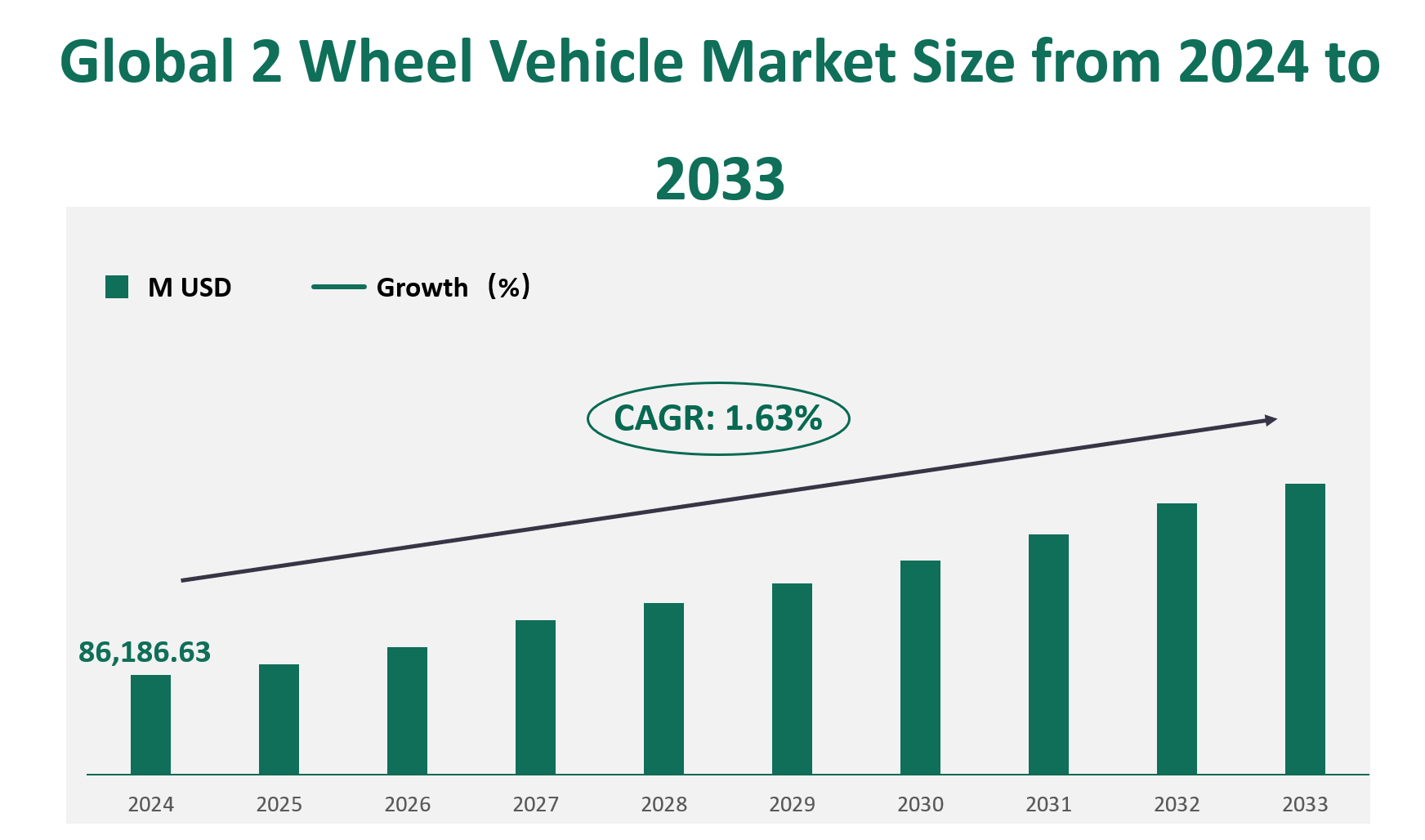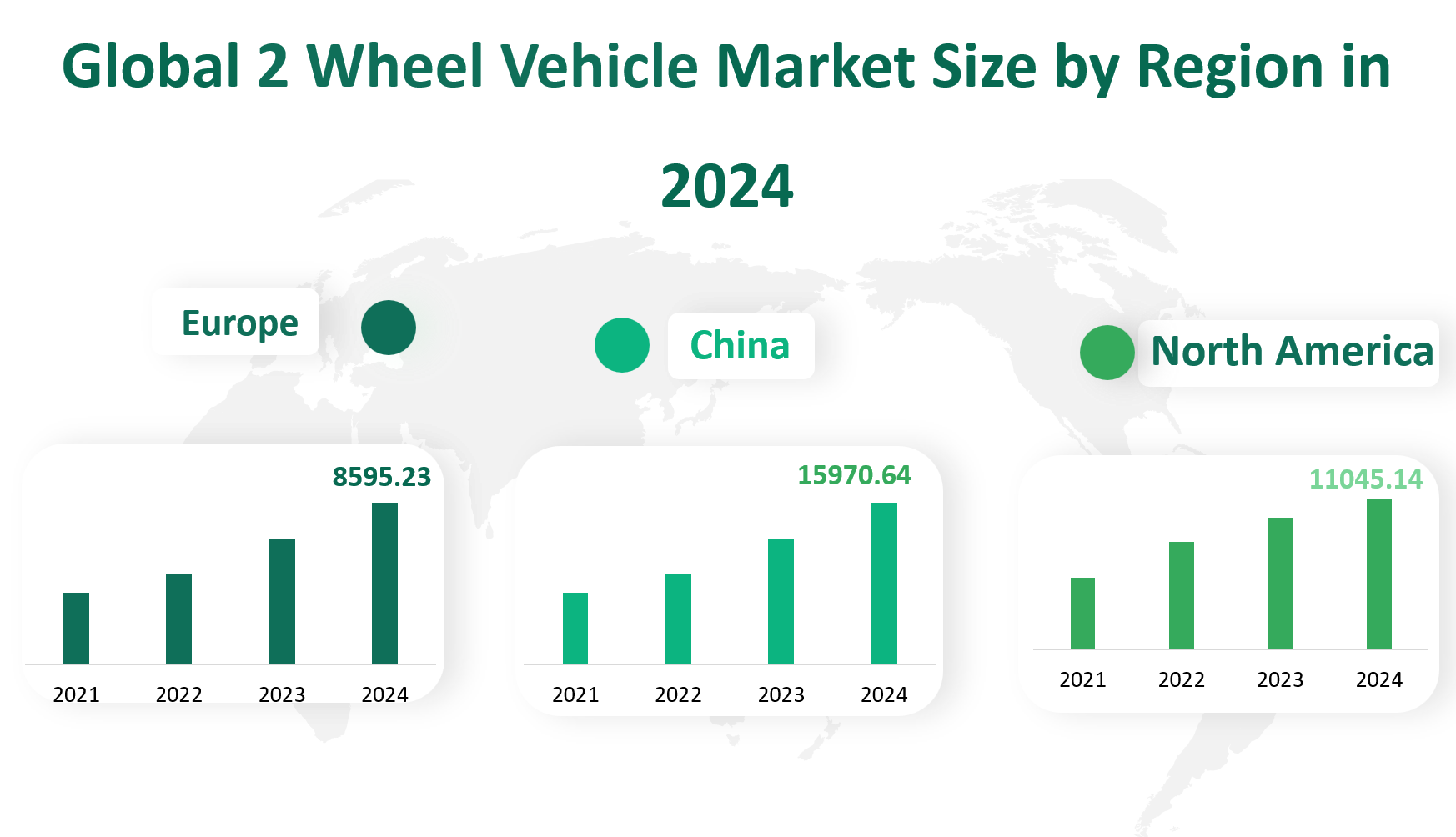1. Global 2 Wheel Vehicle Market Insight Analysis
The global two-wheeled vehicle market is projected to reach a value of 86,186.63 million USD by 2024, with a compound annual growth rate (CAGR) of 1.63% from 2024 to 2033.
A two-wheeled vehicle is defined as a vehicle that operates on two wheels arranged either in series or side by side. These vehicles can be powered by various means, including internal combustion engines (powered two-wheeled vehicles) or electric motors (electric two-wheeled vehicles). The market encompasses a wide range of products, from traditional motorcycles and scooters to modern electric bikes and e-scooters. The versatility and efficiency of two-wheeled vehicles make them popular for various applications, including daily commuting, racing, off-road use, and other specialized purposes.
Figure Global 2 Wheel Vehicle Market Size (M USD) and CAGR (2024-2033)

2. Driving and Limiting Factors of 2 Wheel Vehicle Market Growth
Economic Development: Emerging economies, particularly in Asia, are experiencing rapid economic growth, leading to increased disposable incomes and higher demand for personal transportation. This trend is particularly evident in countries like India and China, which have become major markets for two-wheeled vehicles.
Technological Advancements: Innovations in engine technology, materials science, and electronics have led to the development of more efficient, reliable, and environmentally friendly two-wheeled vehicles. Electric two-wheeled vehicles, in particular, are gaining popularity due to their zero-emission operation and lower operating costs.
Urbanization: The increasing trend of urbanization has led to higher demand for compact and efficient transportation solutions. Two-wheeled vehicles are well-suited for navigating congested urban environments and offer a cost-effective alternative to cars.
Government Policies: Many governments are promoting the use of electric vehicles through subsidies, tax incentives, and infrastructure development. These policies are encouraging both manufacturers and consumers to adopt electric two-wheeled vehicles.
Safety Concerns: Two-wheeled vehicles are generally perceived as less safe compared to four-wheeled vehicles. This perception can deter potential buyers, especially in regions with poor road infrastructure and high accident rates.
Infrastructure Limitations: The lack of dedicated lanes and parking facilities for two-wheeled vehicles can limit their adoption. In many cities, the infrastructure is still primarily designed for cars, making it challenging for two-wheeled vehicles to operate efficiently.
High Initial Costs: Electric two-wheeled vehicles, while cost-effective in the long run, often have higher upfront costs compared to their traditional counterparts. This can be a barrier for price-sensitive consumers.
Regulatory Challenges: Stringent emission regulations and safety standards can increase the cost of compliance for manufacturers, potentially leading to higher prices for consumers.
3. Technology Innovation and Corporate Mergers and Acquisitions in 2 Wheel Vehicle Market
Electric Vehicle Technology: The development of advanced battery technologies, such as lithium-ion and solid-state batteries, is improving the range and performance of electric two-wheeled vehicles. Additionally, advancements in motor technology are enhancing efficiency and power delivery.
Smart Connectivity: Modern two-wheeled vehicles are increasingly equipped with smart features, such as GPS navigation, mobile connectivity, and real-time traffic updates. These features enhance the user experience and provide additional convenience and safety.
Autonomous and Semi-Autonomous Features: While still in the early stages, some manufacturers are exploring the integration of autonomous and semi-autonomous features in two-wheeled vehicles. This includes advanced driver-assistance systems (ADAS) that can improve safety and reduce the risk of accidents.
Strategic Partnerships: Companies are forming strategic partnerships to leverage each other’s strengths. For example, Harley-Davidson’s acquisition of StaCyc, a manufacturer of electric two-wheelers for children, demonstrates the company’s commitment to expanding its electric vehicle portfolio.
Market Expansion: Acquisitions and mergers are helping companies enter new markets and expand their product offerings. TVS Motor’s acquisition of a stake in Ultraviolette, an electric two-wheeler startup, is a notable example of a company investing in future technologies and expanding its presence in the electric vehicle segment.
4. Global 2 Wheel Vehicle Market Size by Type
Powered two-wheeled vehicles are those that rely on internal combustion engines for propulsion. These vehicles are typically fueled by gasoline, diesel, or other fossil fuels. They include motorcycles, scooters, and mopeds designed for various purposes, such as daily commuting, racing, and off-road use. Powered two-wheeled vehicles have long dominated the market due to their versatility, performance, and reliability.
By 2024, the market value of powered two-wheeled vehicles is projected to reach approximately $68,002.98 million USD. This segment is expected to hold the largest market share, accounting for around 78.90% of the total two-wheeled vehicle market.
Electric two-wheeled vehicles (e-bikes and e-scooters) are gaining traction as environmentally friendly alternatives to traditional powered vehicles. These vehicles are powered by electric motors and rechargeable batteries, offering a sustainable and cost-effective mode of transportation. The market value of electric two-wheeled vehicles is projected to reach $18,183.65 million USD by 2024. While this segment is growing rapidly, it is still expected to hold a smaller market share of around 21.10%.
Table Global 2 Wheel Vehicle Market Size by Type in 2024
5. Global 2 Wheel Vehicle Market Size by Application
The primary application of two-wheeled vehicles is daily commuting. These vehicles are used by millions of people worldwide to travel to and from work, school, and other daily activities. The convenience, affordability, and ease of parking make two-wheeled vehicles an ideal choice for urban commuters. The market value for two-wheeled vehicles used in daily commuting is projected to reach $73,215.54 million USD by 2024. This application is expected to hold the largest market share, accounting for approximately 84.95% of the total market.
Racing is another significant application of two-wheeled vehicles, particularly in the sports and entertainment sectors. High-performance motorcycles and scooters are designed for speed and agility, making them suitable for competitive racing events. The market value for racing applications is projected to reach $6,489.85 million USD by 2024. This segment is expected to hold a market share of around 7.53%.
Off-road two-wheeled vehicles are designed for rugged terrain and outdoor activities. These vehicles are equipped with features such as high ground clearance, robust suspension systems, and powerful engines to handle challenging environments. The market value for off-road applications is projected to reach $3,809.45 million USD by 2024. This segment is expected to hold a market share of around 4.42%.
Table Global 2 Wheel Vehicle Market Size by Application in 2024
Application | Market Size (M USD) 2024 |
Racing | 6489.85 |
Daily Commute | 73215.54 |
Off-road Use | 3809.45 |
Other | 2671.79 |
6. Global 2 Wheel Vehicle Market by Top Regions
The North American market is projected to be valued at 11045.14 million USD in 2024. This region has a mature market with a strong focus on high-performance motorcycles and electric two-wheelers. The market is driven by technological advancements and a growing interest in environmentally friendly transportation options.
Europe is expected to have a market value of 8595.23 million USD in 2024. Similar to North America, Europe has a mature market with a strong emphasis on high-end motorcycles and scooters. The region benefits from advanced technology and a well-developed infrastructure. However, economic uncertainties and regulatory challenges are limiting factors.
China is anticipated to be the largest regional market by revenue, with a projected value of 15970.64 million USD in 2024. The Chinese market is characterized by a large consumer base and rapid economic growth. The demand for two-wheeled vehicles is driven by both daily commuting and recreational use. The market is also witnessing a significant shift towards electric vehicles, supported by government policies and technological advancements.
India is the fastest-growing regional market, with a projected value of 33750.84 million USD in 2024. The Indian market is experiencing rapid growth due to increasing urbanization, rising disposable incomes, and a strong demand for affordable transportation. The market is dominated by motorcycles and scooters, with a growing segment of electric vehicles.
Japan is expected to have a market value of 1547.87 million USD in 2024. The Japanese market is known for its high-quality motorcycles and scooters, with a strong focus on innovation and technology. However, the market growth is relatively slow due to a mature market and a declining population.
The Middle East and Africa region is projected to be valued at 1550.19 million USD in 2024. This region is experiencing steady growth due to increasing economic development and a growing demand for motorcycles and scooters. The market is also benefiting from investments in infrastructure and technology.
South America is expected to have a market value of 3150.69 million USD in 2024. The region is experiencing growth due to increasing urbanization and a growing middle class. However, economic uncertainties and infrastructure challenges are limiting factors.
Figure Global 2 Wheel Vehicle Market Size by Region in 2024

7. Global 2 Wheel Vehicle Market Analysis by Major Players
7.1 Honda Motor
Company Introduction and Business Overview: Honda Motor, founded in 1948, is a Japanese multinational conglomerate known for its automobiles, motorcycles, and power equipment. Honda has a global presence and is renowned for its innovation and quality.
Products Offered: Honda offers a wide range of two-wheeled vehicles, including motorcycles, scooters, and electric bikes. Their products are known for their reliability, performance, and fuel efficiency.
7.2 Yamaha Motor
Company Introduction and Business Overview: Yamaha Motor, established in 1955, is a Japanese company that develops and sells motorcycles, marine products, and power products. Yamaha is known for its high-performance motorcycles and scooters.
Products Offered: Yamaha offers a diverse range of two-wheeled vehicles, including sports motorcycles, scooters, and electric bikes. Their products are recognized for their advanced technology and design.
7.3 Hero MotoCorp
Company Introduction and Business Overview: Hero MotoCorp, founded in 1984, is an Indian company and the world’s largest manufacturer of motorcycles and scooters. The company is known for its affordable and reliable products.
Products Offered: Hero MotoCorp offers a wide range of motorcycles and scooters, catering to both daily commuters and enthusiasts. Their products are known for their durability and fuel efficiency.

